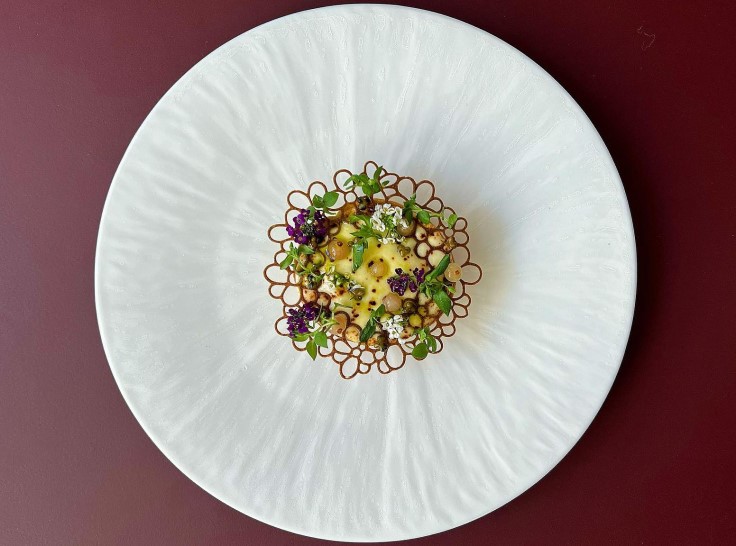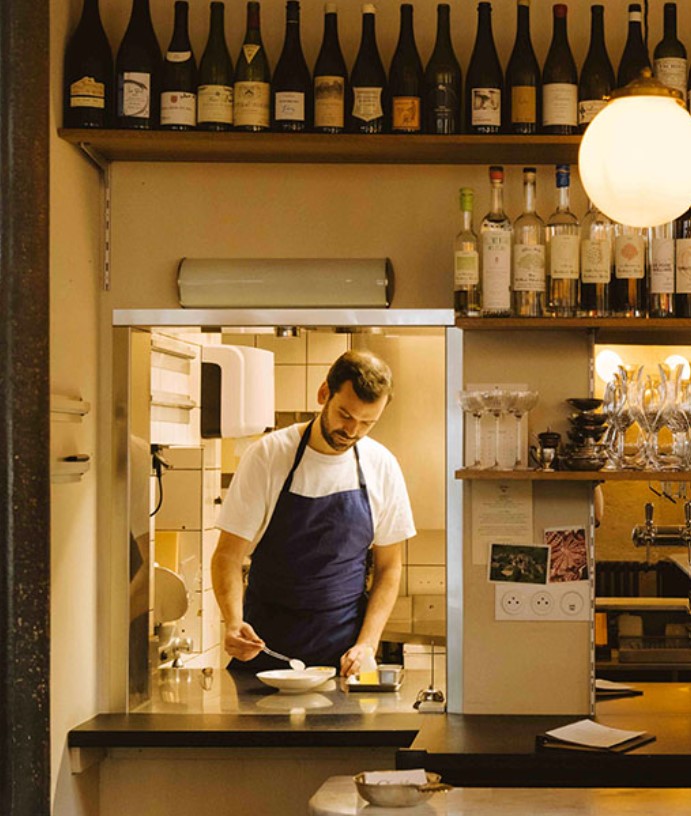Over half of Denmark’s Michelin-Starred restaurants can be found in its laid-back capital city. Beyond its gastronomic delights, of which there is no shortage, Copenhagen is the epitome of Nordic culture. Spread over the islands of Zealand and Amager, a stone’s throw across the Øresund Strait from Sweden, Copenhagen packs in plenty of history beneath its trendy, modern façade. Its compact city centre and exceptional transport links with the rest of Europe make it the ideal Nordic city break destination. This is how to make the most of 48 hours in Copenhagen, in true MICHELIN Guide style.

Day 1: Royalty and Regal Buildings
Morning
In a city surrounded by water, there seems no place more fitting to start your time in Copenhagen than alongside the Øresund. This famous strait forms a natural border between Denmark and Sweden, with Copenhagen sitting just 25 miles from Malmö. It is the Øresund, too, which separates Zealand and Amager.Start your morning with a stroll across Indershavnbrog, a modern footbridge which connects the two islands, providing a stunning view of Copenhagen’s modernist Opera House. On the Zealand side of the bridge, pause for breakfast at The Union Kitchen. Copenhagen’s most-loved brunch venue, their extensive menu has everything from light and healthy Nordic favourites to indulgent treats from the other side of the Atlantic.

Suitably fuelled for a morning of exploration, follow the path alongside the Øresund to Amalienborg. The official residence of the Danish Royal Family, Amalienborg was completed in 1760 and comprises four separate palaces which, together, make up Frederik VIII’s palace complex. Frederik VIII himself, who served as King of Denmark from 1906 to 1912, resided in Brockdorff Palace which is home to incumbent King Frederik X and Queen Mary.
The three other palaces (Moltke’s Palace, Levetzau’s Palace and Schack’s Palace) and Brockdorff have identical classical façades and are set around an octagonal courtyard. Their interiors, designed in late baroque rococo style, are lavish, and a stark contrast to the modern minimalistic designs famous across the Nordic countries.
If you visit at the weekend, pay a visit to HM The King’s Reference Library. The private collection of the Danish monarch, the library houses over 100,000 items. Whilst access to the books is limited to members of the royal family and their court, visitors to Amalienborg are able to enter the beautiful study room every weekend.
The highlight of any visit to Amalienborg is witnessing the Changing of the Royal Guard which takes place daily at noon. The guards march 2 kilometres from Rosenborg Castle through the city streets to reach Amalienborg where the event takes place.

Lunch
Leaving Amalienborg via the Amaliegade exit, follow the reverse of the route taken by the Royal Guard to Rosenborg Palace. Just to the right of the gate, royal-themed restaurant Amalie seems an appropriate place to pause for lunch. Set in a charming 18th-century townhouse, its walls are adorned with portraits of former monarchs, and its menu is as traditional as its décor. For a true taste of Denmark, try one of their herring dishes; the menu features this Danish staple cooked in every way imaginable.
Afternoon
Continuing north, follow Dronningens Tværgade, originally built to link the the Queen’s Garden at Amalienborg with the King’s Garden at Rosenborg Castle. After around 10 minutes, you’ll reach the entrance to the gardens.The King’s Garden was established in 1606, making it the oldest park in Copenhagen. Covering 12 hectares, two diagonal lime tree avenues run the length of the garden from the entrances at the King’s Gate (Knight’s Path) and the Queen’s Gate (Lady’s Path), meeting at the very centre of the park.
Rosenborg Castle sits at the head of the Knight’s Path. Built at the same time as the gardens, the castle was intended to serve as a country summerhouse for King Christian IV. At the time of its construction, the city of Copenhagen only occupied a fraction of the land it does today; Rosenborg was surrounded by rolling fields and green forests.
Heavily protected by the King’s Life Guards, the castle is home to the Danish treasury, which in turn holds the royal family’s most valuable collection: the crown jewels. Along with all the regalia of the Danish crown, throne and the Persian Coronation Carpet, the jewels are on display to the public and are a highlight of any visit to Rosenborg.
Directly behind the castle, Copenhagen Botanical Garden is home to the largest collection of plants in Denmark. Free to enter, it is the perfect place to relax at the end of a busy day of sightseeing. Be sure to pay a visit to the iconic glass Palm House at its centre and, if you visit during the summer months, make sure you explore the fascinating Butterfly House too.

Dinner and Evening
Skirt the edge of the King’s Garden to reach Møntergade, an upscale Danish bistro famous for its seafood-heavy menu. Cosy and relaxed, the highlights of this Bib Gourmand brasserie are the kitchen's daily specials, which make the most of fresh, seasonal produce.Dinner complete, round off your first evening in Copenhagen at the city’s first champagne bar: Balthazar at hotel d’Angleterre. Overlooking the cobbled Kongens Nytorv Square featuring a statue of King Christian V on horseback, it's decked out in a lavish Parisian style and comes with an extensive champagne list.
In addition to the excellent bar, d’Angleterre, Copenhagen boasts 92 elegant rooms which perfectly preserve the hotel’s 250-year history, but without lacking in modern conveniences. An alternative option for dinner, Marchal, their One-Michelin-Starred restaurant, offers contemporary French cuisine which includes an impressive caviar selection.
Day 2: Fairy Tales, Waterways and Tivoli
Morning
Having explored Copenhagen’s regal history, spend your second day delving into the culture which makes the Danish capital one of the happiest cities in the world. For breakfast, head to the Michelin-recommended Nimb hotel. Backing on to the world-famous Tivoli Gardens, to which we shall return later in the day, Nimb’s welcoming charm makes it feel more like a home than a top hotel. The Nimb Brasserie serves a traditional breakfast in refined yet relaxed surroundings, and there's also a weekend brunch for those who like to linger over their meal. After that, pop to the wonderful spa and you'll be fully set up for the day.
From Nimb, take a short walk east passing the grand Radhus, Copenhagen’s City Hall. Completed in 1905, the Radhus has served as the city’s main council chambers ever since. The design was inspired by Romantic-style Italian town halls and it’s well worth spending a few minutes admiring the detailed interior. Guided tours are available once a day, except on Sundays, which provide a valuable insight into the building’s history and the workings of the city council.
Directly opposite the Radhus on Radhuspladsen is the Hans Christian Andersen Experience. Born in 1805 in Odense, 255 kilometres to the west of Copenhagen, Andersen moved to the capital aged 14, where he was quickly accepted into the Royal Danish Theatre. Away from the stage, he soon became a prolific writer, penning plays, novels, poems and travelogues. It was for his fairy tales, however, that Andersen rose to prominence on the world stage. Published in nine volumes, his 156 children’s stories have been translated into no less than 125 languages and remain popular to this day. The Hans Christian Andersen Experience celebrates his life and works, giving a detailed and fascinating account of his childhood and the journeys which inspired his work.
Likely his most famous and celebrated tale, The Little Mermaid, was published in 1837. It tells the both beautiful and melancholic story of the Little Mermaid who lives in an underwater utopia but has a fascination with humans and life on the surface, and then falls in unrequited love with a prince.
No visit to Copenhagen would be complete without paying homage to her at the Little Mermaid Statue, which is situated on the banks of the Øresund, some 3.5 kilometres from the Hans Christian Andersen Experience. The walk is a pleasant and leisurely one, guiding you through the very heart of Copenhagen and taking approximately 40 minutes at a moderate pace. If you prefer not to walk, a taxi takes less than 10 minutes.
The statue, sculpted by Danish artist Edvard Eriksen, sits atop a rock. Having been commissioned by the master brewer and son of the founder of the Carlsberg Brewery Carl Jacobsen, it was unveiled in 1913 and has since become a Copenhagen icon. True to its name, it measures just 4 feet high.

Lunch and Afternoon
Just a 10-minute walk from The Little Mermaid you'll find The Pescetarian, a busy restaurant that's exactly what you'd expect to find in the Nordic Countries. It has a light, modern, minimalistic interior and, as its name suggests, features a generous selection of locally sourced seafood on its tasting menu (a vegetarian alternative is also available).As an island city, waterways were integral to the founding of Copenhagen, which stays true to its maritime heritage today. Just across the road from The Pescetarian, the Museum of Danish Resistance tells the story of how Copenhagen attempted to free itself from German occupiers during the Second World War.
The only way to fully appreciate the significance of Copenhagen’s waterways, however, is to experience them for yourself. Canal cruises depart several times a day from the Stromma Canal Cruises’ berth on Nyhavn, offering a fully guided one-hour tour of the city’s canals. Travelling through the canal district of Christianshavn, the cruise passes colourful townhouses and cobbled passageways, and provides a different perspective of Amalienborg and The Little Mermaid.

Late Afternoon and Early Evening
Back on dry land, this afternoon’s final port of call is unequivocally Copenhagen’s most famous landmark. Tivoli Gardens is the third-oldest amusement park in the world, having opened to the public in 1843.
A ride on Tivoli’s wooden rollercoaster is a must for thrill seekers, while for those who prefer to keep their feet firmly on terra firma, a stroll around the landscaped gardens as night falls is the perfect way to round off 48 hours in Copenhagen. Admire the Nimb Water Fountains, explore the Chinese-inspired bamboo forest, then lose yourself in the peace and tranquillity of The Pergola Gardens with a serene Japanese pergola as their centrepiece. The pagoda also plays host to rotating pop-ups from world-renowned guest chefs, so grab yourself a bite before you leave.
Conclude your evening at Tivoli with a walk down The Alley, a replica of a traditional Danish market town, where you can admire shop signs from yesteryear and pick up handicrafts and gifts from old world shops and market stalls.
Related Read: Anneberg Kulturpark and Tivoli Gardens to Host the 2025 & 2026 Nordic Countries Ceremonies

Dinner and Evening
When you feel ready for your final dinner in Copenhagen, you needn't go far, as there's handily a restaurant within Tivoli Gardens itself. Restaurant Glassalen sits inside a gorgeously restored 19th-century glasshouse, its large windows giving it a bright, airy feel; after dark, the glistening lights around the park lend a magical touch that will linger in the memory. Choose between a seasonal tasting menu and an à la carte, both offering classically Danish dishes with a few modern touches.For a fitting wrap to your time in Copenhagen, end your night with a drink in the Courtyard Bar at Michelin-recommended hotel Villa Copenhagen. Sitting under an imposing glass ceiling, the Courtyard Bar is a beautiful blend of Nordic simplicity and international grandeur. Open to overnight guests and visitors until late, the bar boasts an impressive wine list, along with Danish draughts, a comprehensive selection of gins and wonderful handcrafted cocktails and mocktails. If you fancy staying the night, Villa Copenhagen’s 390 luxurious rooms are complemented by a rooftop pool and an onsite bakery which serves fresh, flaky Danish pastries.




















